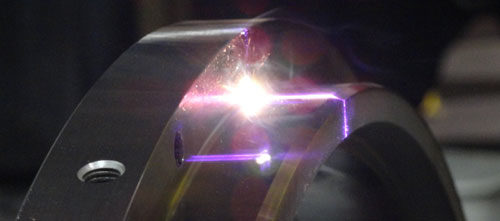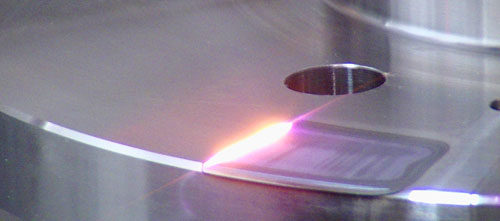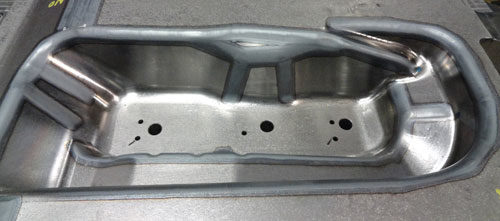Laser heat treating uses laser energy to rapidly and efficiently heat a selected area of a metal component’s surface above the transformational temperature. The thermal mass of the component is all that is required to achieve quenching. A rapid quench necessary for hardening is achieved by removal of the laser energy via conduction. This occurs after turning off the laser or movement of the laser beam over the component’s surface. Rapid heat removal is achieved by the thermal mass of the component acting as a heat-sink. This heat removal rate is typically much higher than those associated with traditional methods and therefore can achieve a higher case hardness.
Diode Laser Heat Treating

Diode Laser Heat Treating
Laser Heat Treating Bearing Retainer

Laser Heat Treating Bearing Retainer
Laser Heat Treat Stamping Die

Laser Heat Treat Stamping Die
Advantages of Laser Heat Treating
All heat treatable materials can be laser case hardened without liquid based quenchants. The low distortion sets laser heat treating apart from traditional heat treating methods such as flame, RF-induction, furnace, carbonizing, and nitriding processes. Flame hardening has poor reproducibility, poor quench, and large distortions. Induction hardening requires precise controls over inductor placement, quenchant chemistries and flow, but still produces large distortions due to large thermal penetration. Furnace, carbonizing and nitriding processes are all inherently non-localized and therefore are distortion risks. The major advantage of diode laser surface hardening is the high processing speed with precise case-depths resulting in negligible distortion. Laser surface transformation hardening not only increases the wear resistance but also increases fatigue strength due to compressive stresses induced on the work piece surface, under the right conditions. This is especially true of powder metal parts and high torque parts such as cams, cranks, and couplings.
Laser Heat Treating Cost Advantage
Titanova diode laser heat treating service is a much more cost effective heat treating technique when compared to traditional heat treating processes when one considers first time quality, turnaround time, pre and post part processing requirements. The diode laser heat-treating process is inherently a LEAN (single piece flow) process. Since diode laser heat treating is a localized heat treat, only where the laser beam points, distortion can be significantly reduced or eliminated. For ferritic cast irons we use a laser glazing process. Learn more about Laser Glazing here.
Diode Laser Wavelength Advantage
The diode laser is an ideal source for laser transformation hardening, with the most absorbing wavelength of any laser, the diode requires no pre-coating of a machined workpiece surface to achieve light absorption. The diode laser is inherently solid-state, which allows for in-situ temperature control, thus we can provide a level of quality not achievable with any other heat-treating process.
<Learn more about the benefits of the laser hardening process.>
Applications
- Carbon alloy steels and cast irons
- Bearing surfaces
- Cutting surfaces
- Pumps
- Valve seat and seal surfaces
- Drive train components
- Gears, pulleys and cams
- Hand tools, needles and pins
- Forming tools
- Stamping dies
- Turbine blades
- Powder metal parts
Benefits
- Selective hardening both is depth and location
- Low or negligible distortion
- No post processing is required
- Precision heating and control
- Highly directional heating via line of site heat treating
- Process speeds typically 3 times the rate of induction
- Environmentally friendly dry process requiring no quench oil or fluids
- Process does not require absorbent coatings
- Process very forgiving with respect to surface contaminants
- Work piece shape geometry not an issue
- Higher hardness achievable — over HRC 60 without cracking
- Fatigue life improvement for powder metal parts and drive train components
- Quality processing achievable with in situ temperature control
